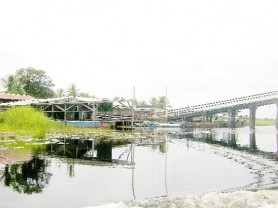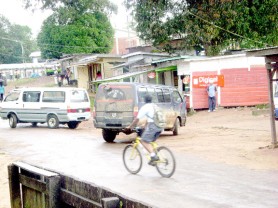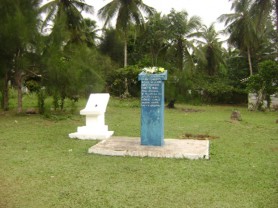– cellphones, minibuses becoming commonplace
An increase in economic activities at Moruca in the North West is anticipated to spur development, providing the villages within the area are afforded support from the administration.

This is according to residents of the sub-region, one of three within Region One. It is nestled along the coastland and positioned as a central connection point for river traffic linking the coast to areas within the region, including the main administrative office at Mabaruma.
While the communities of Moruca are riverain, an accessible road network, connects villages such as Kwebanna, Waramuri, Kamwatta and Manawarin with Santa Rosa, the administrative centre for the area. Several satellite villages are located a few miles away, among them Kamwatta and Chinese Landing.
The roads are considered ‘quality roads’ by the bus operators who ply their trade between the villages, transporting mainly schoolchildren and villagers travelling to work. A bus operator told Stabroek News during a recent visit that he decided to invest in a minibus when he noticed that children and villagers from satellite villages outside Santa Rosa would walk several miles to get to school and their workplace.
He said that the roads do pose some problems for the vehicles during the rainy season but his contribution towards the development of the region is what counts. A trip between the central Kumaka waterfront area to Waramuri, which was this year delegated heritage village as part of Amerindian Heritage Month celebrations, lasts approximately 20 minutes with a few winding turns and hilltops to traverse along the way. The $500 fare is understandable, passengers said during a trip last week, taking into consideration vehicle repairs as well as the price of gas in the area. Gasoline at Kumaka is retailed at approximately $1,000 per gallon.

The fewer than 10 minibuses in the area travel most of the day between the villages and it would appear as if there is virtually no shortage of passengers as the buses travel with half their full complement while journeying between the villages. There are taxis available too, with one elderly resident noting that persons will soon forget how to walk the long distances connecting the villages.
Regional Chairman Fermin Singh told Stabroek News recently that the road network is one of several avenues being developed in the area to link the communities. As a basis for development, he said that schoolchildren especially are what are kept in mind where linking the communities via road is concerned.
He said there are “natural plans” to improve infrastructural development in the area, adding that an improved water and electricity supply are on the cards.
Boats travel to and from the Kumaka waterfront and Charity on the Essequibo Coast daily, transporting cargo and passengers. The fare per passenger is about $3,000 and the hour-and-a-half long trip could be adventurous for first-time travellers to the area. The journey from Charity starts with a 20-minute ride out of the Pomeroon River with a few high-cresting waves along the way.

The river meanders out into the open Atlantic Ocean and some 20 minutes later, the boats head towards the Moruca River which is covered by cascading mangroves.
There are sharp turns which pass through swampy, savannah lands with the village of Waramuri, which lies along the right bank of the Moruca River, being one of the first communities along the way. Santa Rosa lies some 15 minutes away and the Kumaka/San Jose Bridge which was constructed recently, can be seen in the distance as the boats arrive at the Kumaka waterfront.
Residents refer to the communities of Kumka, St Peter, Kabakali and San Jose as ‘islands,’ because they are all surrounded by savannahs with accumulated water.
Kumaka waterfront shopkeeper Yvonne Williams expressed the view that the area has some way to go in terms of development, and that businesses there would have to get the necessary support from the government to progress. She said she has seen the business community in the area evolve over the years and she noted that the minibuses and cars are a recent feature, with the first vehicles coming some time after 2004.
Mobile phones are also a noticeable feature at Moruca; persons there noting that almost every household has a mobile phone. Digicel launched its telecommunications service at Moruca two years ago and the investment by the company is viewed as significant by residents.
The Santa Rosa secondary, primary and nursery schools all lie within walking distance of each other and the hospital, police station and post office as well as the office of the Guyana Elections Commission (Gecom) are also situated close to each other.
Persons expressed a few concerns about the health facilities in the sub-region, some noting that drugs are not always available at the health centres. The area recently saw cases of dengue fever, it was reported, with the dormitory facility which houses children close to the secondary school recording multiple cases of students who contracted the disease recently.
The issue of birth certificates was also raised by residents there, and according to a local shopkeeper, she travelled to the city on more than three occasions to have her applications for her children processed but to no avail. She said the problem lies with the applications reaching the offices of the general registrar in the city.
A Chinese Landing village councillor, who asked not to be named, also stated that the issue was affecting persons in his village and he said there are less than 10 persons in the village who possess birth certificates. He also pointed to an existing problem of a coastlander mining illegally on village lands at Chinese Landing and noted that the Guyana Geology and Mines Commission (GGMC) is aware of the issue but the concerns of the council appear to be falling on deaf ears.
The main economic activities in the Moruca sub-region are fishing, mining and farming. Farming is done on a large scale and farmers transport their produce to Charity for resale. Some 12,000 people live at Moruca, the highest concentration of the population being in the Santa Rosa/Kumaka area.
The communities are occupied by mainly Amerindians from the Arawak and Warau tribes.




